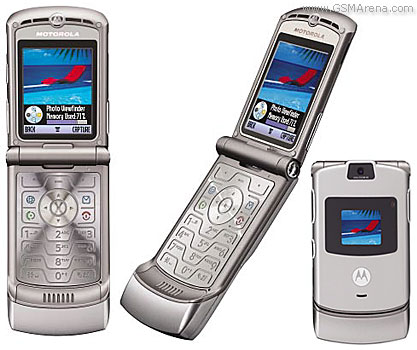One of the most popular phones ever made is Motorola’s first Razr V3. Its sleek form and anodized aluminum finish gave it a futuristic appearance when it was first debuted in 2004. The allure was further enhanced by the blue illuminated keyboard that was carved from a single piece of metal. And to get one, people waited in line.

The Motorola Razr V3 was released in 2004 and featured a 1.3-megapixel camera and a tiny, color external screen. Because of its excellent craftsmanship, ultra-slim design, and premium materials, it quickly became a symbol. The Razr is one of the best-selling phones ever, with 130 million sold.
The Razr V3 was the thinnest phone available at the time. And although it appeared rather wide compared to its thinness, it easily fitted inside any pocket. The convenience of carrying it around was seductive, compared to other phones.
The first thing you’d notice when you opened the Razr V3 was how ergonomically sound it was, even when used with one hand. To send a quick text, simply swipe your thumb across the V3’s keypad with your preferred hand. Additionally, it was simple to flick the lid open and close.
The 480p (VGA resolution) camera of the V3 took mediocre pictures. The field of view was quite limited, the colors were either oversaturated or undersaturated, and there was purple fringing everywhere.

The Razr was adored by most because of its long battery life. Right out of the box, Motorola rated the 680mAh battery to provide 7 hours of talk time and 280 hours (11 days) of standby life. Totally unheard of in the age of cellphones.
You could voice-dial numbers (as long as they were in the phone’s address book) and it paired well with Bluetooth headsets. The quality of the call was passable but not exceptional. The ringer and speakerphone could wake the dead indoors.
When you flipped it open, a large, sufficiently bright screen and a keypad with slightly elevated rubber numbers engraved onto a metal plate were visible. This greatly simplified dialing; however, the absence of rubber bumps on the four-way selecting buttons above the keypad made them somewhat more slippery.
Software-wise, there was a WAP browser, an AIM client, a simple email client, and support for the newest Java games, including a cool golf game, but not enough power to run many action games. Users could use Motorola’s Mobile PhoneTools program to sync contacts, calendars, photos, and MP3 ringtones with a PC over Bluetooth and a micro USB cord.
Evolution
Motorola increased Razr sales during the following two years by introducing a variety of colors, such as this pink model from 2005, and then lowering prices. By 2007, Razrs were no longer considered premium phones because they cost $49 with a contract.

By 2006, Razrs were available in every possible color. Back then, phone manufacturers frequently offered a wide range of hues, experimenting with new color schemes to boost sales without developing a whole new product.

Motorola kept on making variants of the Razr, like the Razr V3c, MS500, V3m, Verizon Wireless version, V3re, MS500W, V3x, V3i, V3xx, maxx, maxx V6, and maxx Ve. There was even Dolce & Gabbana version that came out in late 2005.
In the United States, the V3 (and its variants) was the most popular cell phone in 2005, 2006, and 2007 and remained best-selling until November 2008. People loved it then, and 21 years later, people still adore it for the memories they created with it.




